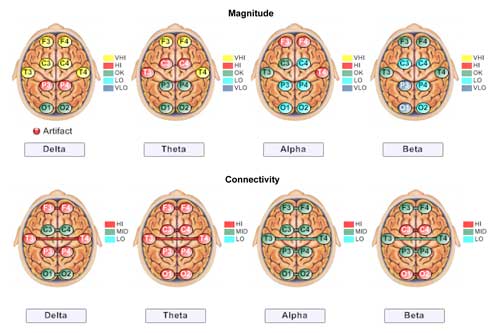Neurofeedback and Brain Mapping
improves:
ADD/ADHD,depression,anxiety,insomnia,fibromyalgia & acute pain,headaches,& more
Neurofeedback is a brain-training therapy backed by dozens of studies proving its effectiveness. It uses computerized EEG technology to identify areas of dysfunction in the brain and then trains the brain to correct them. As a training tool, neurofeedback has been compared to teaching a child to ride a bicycle. Difficult at first, but once the skill is acquired it is never lost.
Neurofeedback has been proven to have beneficial effects for ADD and ADHD, high-functioning autism, depression, anxiety, insomnia, addictions, gait and balance problems, headaches, behavioral problems, fibromyalgia, Lyme disease, and more. It helps balance the brain and the brain is truly the central computer that regulates every function of the body. When it is in balance many seemingly unrelated problems simply vanish.

Neurofeedback is nothing new for my practice as I have been offering it to my patients since the late 90’s. The equipment I used to have was the best available when I purchased it, but over time it had become outdated. Its main drawbacks were that it was not user-friendly, especially not child-friendly, results were slower to achieve than with newer equipment, and it did not offer the full range of diagnostic and treatment options now available.

My new equipment is made by a company called Clear Mind Center, see: www.clearmindcenter.com. With it I am able to provide brain maps instantly through a centralized computer operated by the system’s manufacturer. This is a major advance, not only compared to my old equipment but also other newer systems because brain maps were previously either not available or very expensive. This is because they required many hours of professional work to compile and elaborate the data.
The brain maps provided by this equipment have been scientifically validated and found to offer equivalent data to that obtained with more invasive and far more expensive diagnostic tools, including MRI and SPECT scans. With brain maps you can pinpoint areas of the brain that are depleted of oxygen, have low metabolic activity or are revved up, suffered damage, or show dysfunctions like seizure activity.

Brain maps give us a baseline reading and enable us to design a treatment plan. They can be repeated periodically to monitor progress. Not only do they show the effects of neurofeedback, they can also be used to monitor results from diet change and supplements, or really any other therapy.
In individuals who are gluten-intolerant, the effects on the brain of a gluten-free diet can be readily demonstrated through brain mapping done before and after the implementation of the diet. Among other things, diet can also control seizures, and this too is readily picked up through brain mapping.
Training with this new system is very user-friendly and, actually, pleasant. It is administered while the patient watches his or her favorite movie or other video. The video fades in and out of view depending on how well the brain achieves its training targets.
As goals are met, areas of dysfunction are corrected and problems are resolved. Examples might be anxiety fading or depression lifting. The brain quickly figures out how to self-regulate and benefits are often seen within just a few sessions, although twenty sessions are considered a standard therapeutic unit, and sometimes more are needed to achieve optimal results.
